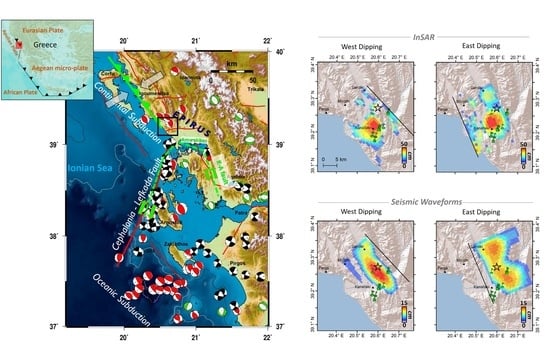Earthquake Source Investigation of the Kanallaki, March 2020 Sequence (North-Western Greece) Based on Seismic and Geodetic Data
Abstract
1. Introduction
2. Data and Methods
2.1. Seismic Analysis
2.2. Geodetic Analysis
3. Results
3.1. Geodetic Source Modelling
3.2. Seismic Source Modelling
3.3. Estimation of the Stress Orientation
4. Discussion and Conclusions
- −
- There is a spatial correlation of the estimated main slip patches with the locations of the observed landslides. Both fault dip directions explain their relative location.
- −
- The Kanallaki village, where the major damage was observed, is close or exactly above the main slip patch in all the presented models.
- −
- The InSAR and seismic waveform slip distributions agree as to the slip pattern: A west dipping fault plane would have slipped in a single main patch, whereas an east-dipping fault would have expressed two main slip patches.
Supplementary Materials
Author Contributions
Funding
Data Availability Statement
Conflicts of Interest
References
- Valkaniotis, S.; Briole, P.; Ganas, A.; Elias, P.; Kapetanidis, V.; Tsironi, V.; Fokaefs, A.; Partheniou, H.; Paschos, P. The Mw = 5.6 Kanallaki Earthquake of 21 March 2020 in West Epirus, Greece: Reverse Fault Model from InSAR Data and Seismotectonic Implications for Apulia-Eurasia Collision. Geosciences 2020, 10, 454. [Google Scholar] [CrossRef]
- Lekkas, E.; Mavroulis, S.; Carydis, P.; Skourtsos, E.; Kaviris, G.; Paschos, P.; Ganas, A.; Kazantzidou-Firtinidou, D.; Parcharidis, I.; Gatsios, T.; et al. The 21 March 2020, Mw 5.7 Epirus (Greece) Earthquake. Newsl. Environ. Disaster Crises Manag. Strateg. 2020, 17, 2653–9454. [Google Scholar]
- Ntokos, D. Neotectonic study of Northwestern Greece. J. Maps 2018, 14, 178–188. [Google Scholar] [CrossRef]
- King, G.C.P.; Tselentis, A.; Gomberg, J.; Molnar, P.; Roecker, S.W.; Sinvhal, H.; Soufleris, C.; Stock, J.M. Microearthquake seismicity and active tectonics of the northwestern Greece. Earth Planet. Sci. Lett. 1983, 66, 279–288. [Google Scholar] [CrossRef]
- Hatzfeld, D.; Kassaras, I.; Panagiotopoulos, D.; Amorese, D.; Makropoulos, K.; Karakaisis, G.; Coutant, O. Microseimicity and strain pattern in northwestern Greece. TECTONICS 1995, 14, 773–785. [Google Scholar] [CrossRef]
- Kiratzi, A.A.; Papadimitriou, E.E.; Papazachos, B.C. Microearthquake survey in the Steno dam site in northwestern Greece. Ann. Geophys. 1987, 5, 161–166. [Google Scholar]
- IGRS–IFP (Institut de Géologie et Recherches du Sous-Sol, Athènes–Institut Français du Pétrole). Etude Géologique de l’Epire (Grèce Nord-occidentale); Editions Technip: Paris, France, 1966; p. 306. [Google Scholar]
- Makris, J. Geophysics and geodynamic implications for the evolution of the Hellenides. In Geological Evolution of the Mediterranean Basin; Stanley, J.D., Wezel, F.C., Eds.; Springer: Berlin/Heidelberg, Germany, 1985; pp. 231–248. [Google Scholar]
- Tselentis, A.; Sokos, E.; Martakis, N.; Serpetsidaki, A. Seismicity and Seismotectonics in Epirus, Western Greece: Results from a Microearthquake Survey. Bull. Seismol. Soc. Am. 2006, 96, 1706–1717. [Google Scholar] [CrossRef]
- Kiratzi, A. Mechanisms of Earthquakes in Aegean. In Encyclopedia of Earthquake Engineering; Beer, M., Kougioumtzoglou, I.A., Patelli, E., Siu-Kui Au, I., Eds.; Springer: Berlin/Heidelberg, Germany, 2015; pp. 1–22. [Google Scholar]
- Haddad, A.; Ganas, A.; Kassaras, I.; Lupi, M. Seismicity and geodynamics of western Peloponnese and central Ionian Islands: Insights from a local seismic deployment. Tectonophysics 2020, 778, 228353. [Google Scholar] [CrossRef]
- Pérouse, E.; Sébrier, M.; Braucher, R.; Chamot-Rooke, N.; Bourlès, D.; Briole, P.; Sorel, D.; Dimitrov, D.; Arsenikos, S. Transition from collision to subduction in Western Greece: The Katouna-Stamna active fault system and regional kinematics. Int. J. Earth Sci. 2017, 106, 967–989. [Google Scholar] [CrossRef]
- Kiratzi, A.; Sokos, E.; Ganas, A.; Tselentis, A.; Benetatos, C.; Roumelioti, Z.; Serpetsidaki, A.; Andriopoulos, G.; Galanis, O.; Petrou, P. The April 2007 earthquake swarm near Lake Trichonis and implications for active tectonics in western Greece. Tectonophysics 2008, 452, 51–65. [Google Scholar] [CrossRef]
- Scordilis, M.; Karakaisis, F.; Karacostas, G.; Panagiotopoulos, G.; Comninakis, E.; Papazachos, C. Evidence for transform faulting in the Ionian Sea: The Cephalonia Island earthquake sequence of 1983. PAGEOPH 1985, 123, 388–397. [Google Scholar] [CrossRef]
- Louvari, E.; Kiratzi, A.; Papazachos, B.C. The Cephalonia Transform Fault and its continuation to westernLefkada Island. Tectonophysics 1999, 308, 223–236. [Google Scholar] [CrossRef]
- Kostoglou, A.; Karakostas, V.; Bountzis, P.; Papadimitriou, E. Τhe February–March 2019 Seismic Swarm Offshore North Lefkada Island, Greece: Microseismicity Analysis and Geodynamic Implications. Appl. Sci. 2020, 10, 4491. [Google Scholar] [CrossRef]
- Caputo, R.; Pavlides, S. The Greek Database of Seismogenic Sources (GreDaSS), Version 2.0.0: A Compilation of Potential Seismogenic Sources (Mw > 5.5) in the Aegean Region 2013. Available online: http://gredass.unife.it/ (accessed on 5 January 2021).
- King, G.; Sturdy, D.; Whitney, J. The landscape geometry and active tectonics of the northwest Greece. Geol. Soc. Am. Bull. 1993, 105, 137–161. [Google Scholar] [CrossRef]
- Novotný, O.; Zahradník, J.; Tselentis, G. Northwestern Turkey earthquakes and the structure inferred from surface waves observed in Western Greece. Bull. Seismol. Soc. Amer. 2001, 91, 875–879. [Google Scholar] [CrossRef]
- Dreger, D.S. Time-Domain Moment Tensor INVerse Code (TDMT INVC) Version 1.1., 18; Berkeley Seismological Laboratory: Barkeley, CA, USA, 2002. [Google Scholar]
- Dreger, D.S. TDMT INV: Time domain seismic moment tensor INVersion. In International Handbook of Earthquake and Engineering Seismology; Lee, W.H.K., Kanamori, H., Jennings, P.C., Kisslinger, C., Eds.; Academic Press: Cambridge, MA, USA, 2002; p. 1627. [Google Scholar]
- Dreger, D.S. Berkeley seismic moment tensor method, uncertainty analysis, and study of non-double-couple seismic events. In Moment Tensor Solutions; Amico, S.D., Ed.; Springer Natural Hazards: Berlin/Heidelberg, Germany, 2018; pp. 75–92. [Google Scholar]
- Dreger, D.S.; Kaverina, A. Seismic remote sensing for the earthquake source process and near-source strong shaking: A case study of the 16 October 1999 Hector Mine earthquake. Geophys. Res. Lett. 2000, 27, 1941–1944. [Google Scholar] [CrossRef]
- Kaverina, A.; Dreger, D.; Price, E. The Combined Inversion of Seismic and Geodetic Data for the Source Process of the 16 October 1999 M 7.1 Hector Mine, California, Earthquake. Bull. Seism. Soc. Am. 2002, 92, 1266–1280. [Google Scholar] [CrossRef]
- Vavryčuk, V. Iterative joint inversion for stress and fault orientations from focal mechanisms. Geophys. J. Int. 2014, 199, 69–77. [Google Scholar] [CrossRef]
- Wallace, R.E. Geometry of shearing stress and relation to faulting. J. Geol. 1951, 59, 118–130. [Google Scholar] [CrossRef]
- Bott, M.H.P. The mechanics of oblique slip faulting. Geol. Mag. 1959, 96, 109–117. [Google Scholar] [CrossRef]
- Maury, J.; Cornet, F.H.; Dorbath, L. A review of methods for determining stress fields from earthquake focal mechanisms: Application to the Sierentz 1980 seismic crisis (Upper Rhine graben). Bull. Soc. Geol. Fr. 2013, 184, 319–334. [Google Scholar] [CrossRef]
- Vavryčuk, V. Earthquake mechanisms and stress field. In Encyclopedia of Earthquake Engineering; Beer, M., Ed.; Springer: Berlin, Germany, 2015; pp. 728–746. [Google Scholar] [CrossRef]
- Michael, A.J. Determination of stress from slip data: Faults and folds. J. Geophys. Res. 1984, 89, 11517–11526. [Google Scholar]
- Michael, A.J. Use of focal mechanisms to determine stress: A control study. J. Geophys. Res. 1987, 92, 357–368. [Google Scholar] [CrossRef]
- Lund, B.; Slunga, R. Stress tensor inversion using detailed microearthquake information and stability constraints: Application to Ölfus in southwest Iceland. J. Geophys. Res. 1999, 104, 14947–14964. [Google Scholar] [CrossRef]
- Fojtikova, L.; Vavryčuk, V. Tectonic stress regime in the 2003–2004 and 2012–2015 earthquake swarms in the Ubaye Valley, French Alps. Pure Appl. Geophys 2018, 175, 1997–2008. [Google Scholar] [CrossRef]
- Carvalho, J.; Vieira Barros, L.; Zahradník, J. Focal mechanisms and moment magnitudes of micro-earthquakes in central Brazil by waveform inversion with quality assessment and inference of the local stress field. J. South Am. Earth Sci. 2016, 71, 333–343. [Google Scholar]
- Massonnet, D. Satellite radar interferometry. Sci. Am. 1997, 276, 46–53. [Google Scholar]
- Massonnet, D.; Feigl, K.L. Radar interferometry and its application to changes in the Earth’s surface. Rev. Geophys. 1998, 36, 441–500. [Google Scholar] [CrossRef]
- Goldstein, R.; Werner, C. Radar Interferogram filtering for geophysical applications Radar interferogram filtering for geophysical applications. Geophys. Res. Lett. 1998, 25, 4035–4038. [Google Scholar]
- Costantini, M. A novel phase unwrapping method based on network programming. Geosci. Remote Sens. 1998, 36, 813–821. [Google Scholar]
- Farr, T.G.; Kobrick, M. Shuttle radar topography mission produces a wealth of data. EOS Trans. Am. Geophys. Un. 2000, 81, 583–585. [Google Scholar] [CrossRef]
- Yu, C.; Penna, N.T.; Li, Z. Generation of real-time mode high resolution water vapor fields from GPS observations. J. Geophys. Res. Atmos. 2017, 122, 2008–2025. [Google Scholar] [CrossRef]
- Yu, C.; Li, Z.; Penna, N.T.; Crippa, P. Generic atmospheric correction model for Interferometric Synthetic Aperture Radar observations. J. Geophys. Res. Solid Earth 2018, 123. [Google Scholar] [CrossRef]
- Yu, C.; Li, Z.; Penna, N.T. Interferometric synthetic aperture radar atmospheric correction using a GPS-based iterative tropospheric decomposition model. Remote Sens. Environ. 2018, 204, 109–121. [Google Scholar] [CrossRef]
- Levenberg, K. A method for the solution of certain problems in least squares. Q. Appl. Math. 1944, 2, 164–168. [Google Scholar] [CrossRef]
- Marquardt, D. An algorithm for least-squares estimation of nonlinear parameters. SIAM J. Appl. Math. 1963, 11, 431–441. [Google Scholar] [CrossRef]
- Okada, Y. Surface deformation due to shear and tensile faults in a half-space. Bull. Seism. Soc. Am. 1985, 75, 1135–1154. [Google Scholar]
- Hunstad, I.; Chini, M.; Salvi, S.; Tolomei, C.C.; Bignami, S.; Stramondo, E.; Trasatti, A. Finite fault inversion of DInSAR coseismic displacement of the 2009 L’Aquila earthquake (central Italy). Geophys. Res. Lett. 2009, 36, 15305. [Google Scholar] [CrossRef]
- Atzori, S.; Tolomei, C.; Antonioli, A.; Merryman Boncori, J.P.; Bannister, S.; Trasatti, E.; Pasquali, P.; Salvi, S. The 2010–2011 Canterbury, New Zealand, seismic sequence: Multiple source analysis from InSAR data and modeling. J. Geophys. Res. 2012, 117, 08305. [Google Scholar] [CrossRef]
- Atzori, S.; Antonioli, A.; Tolomei, C.; Novellis, V.; De Luca, C.; Monterroso, F. InSAR full-resolution analysis of the 2017–2018 M > 6 earthquakes in Mexico. Remote Sens. Environ. 2019, 234, 111461. [Google Scholar] [CrossRef]
- Menke, W. Geophysical Data Analysis: Discrete Inverse Theory; Academic Press: Cambridge, MA, USA, 1989. [Google Scholar]
- Papazachos, B.C.; Scordilis, E.M.; Panagiotopoulos, D.G.; Papazachos, C.B.; Karakaisis, G.F. Global relations between seismic fault parameters and moment magnitude of earthquakes. Bull. Geol. Soc. Greece 2004, 36. [Google Scholar] [CrossRef]
- Kapetanidis, V.; Kassaras, I. Contemporary crustal stress of the Greek region deduced from earthquake focal mechanisms. J. Geodyn. 2019, 123, 55–82. [Google Scholar] [CrossRef]
- Konstantinou, K.I.; Mouslopoulou, V.; Liang, W.-T.; Heidbach, O.; Oncken, O.; Suppe, J. Present-day crustal stress field in Greece inferred from regional-scale damped inversion of earthquake focal mechanisms. J. Geophys. Res. Solid Earth 2017, 122, 506–523. [Google Scholar] [CrossRef]
- Sokos, E.; Zahradník, J.; Gallovič, F.; Serpetsidaki, A.; Plicka, V.; Kiratzi, A. Asperity break after 12 years: The Mw6.4 2015 Lefkada (Greece) earthquake. Geophys. Res. Lett. 2016, 43, 6137–6145. [Google Scholar] [CrossRef]
- Vallée, M.; Douet, V. A new database of source time functions (STFs) extracted from the SCARDEC method. Phys. Earth Planet. Inter. 2016, 257, 149–157. [Google Scholar] [CrossRef]
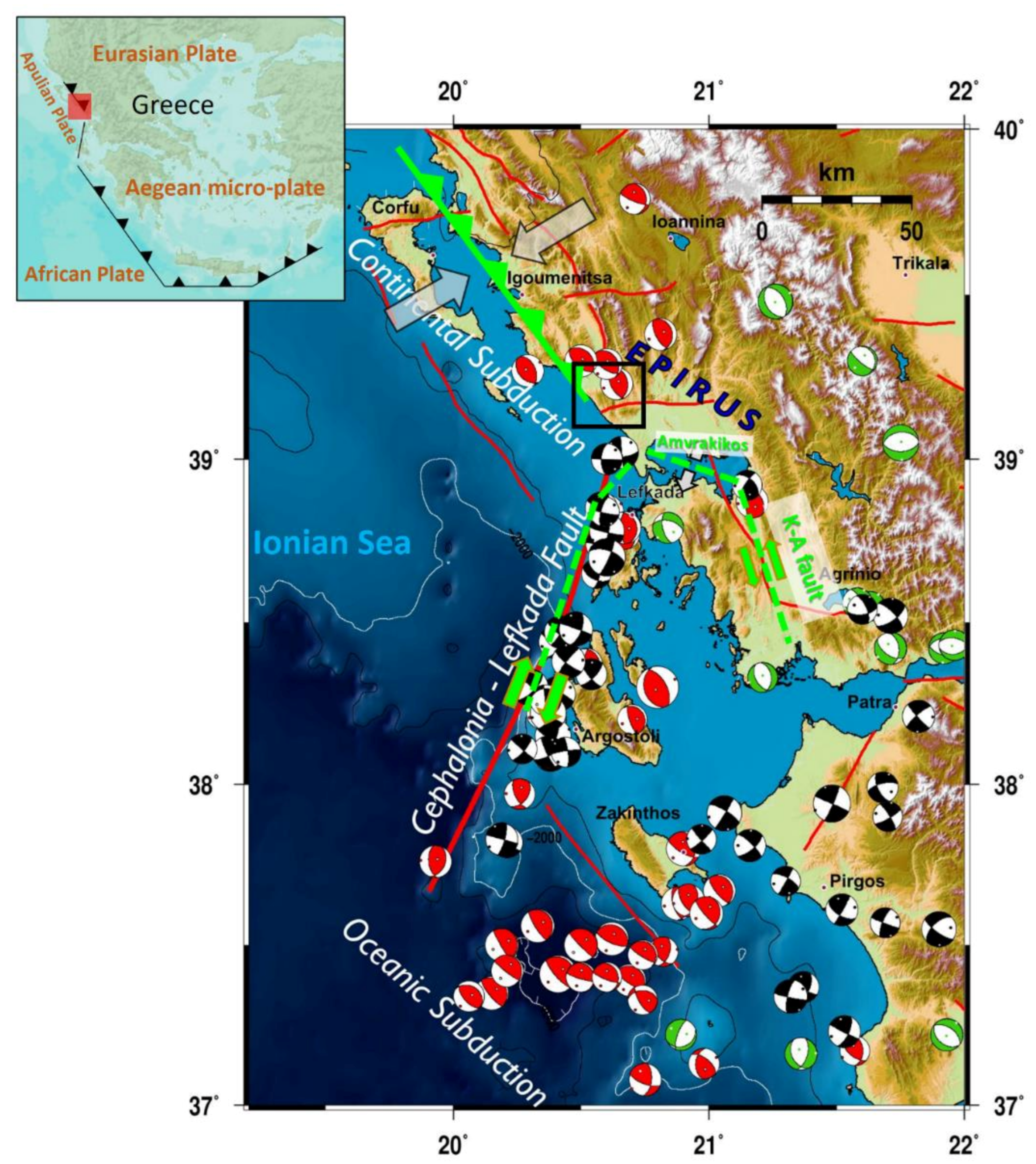
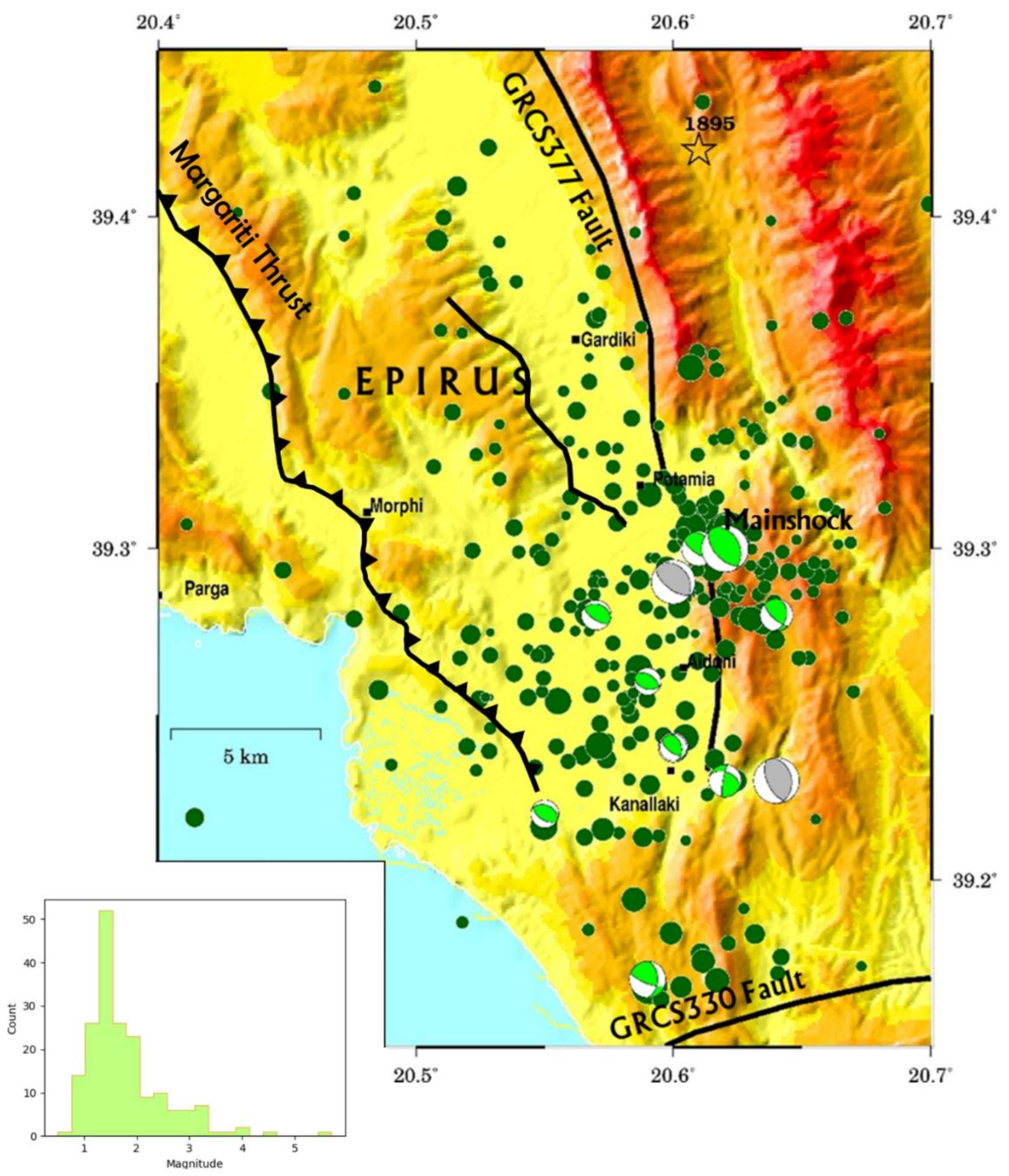
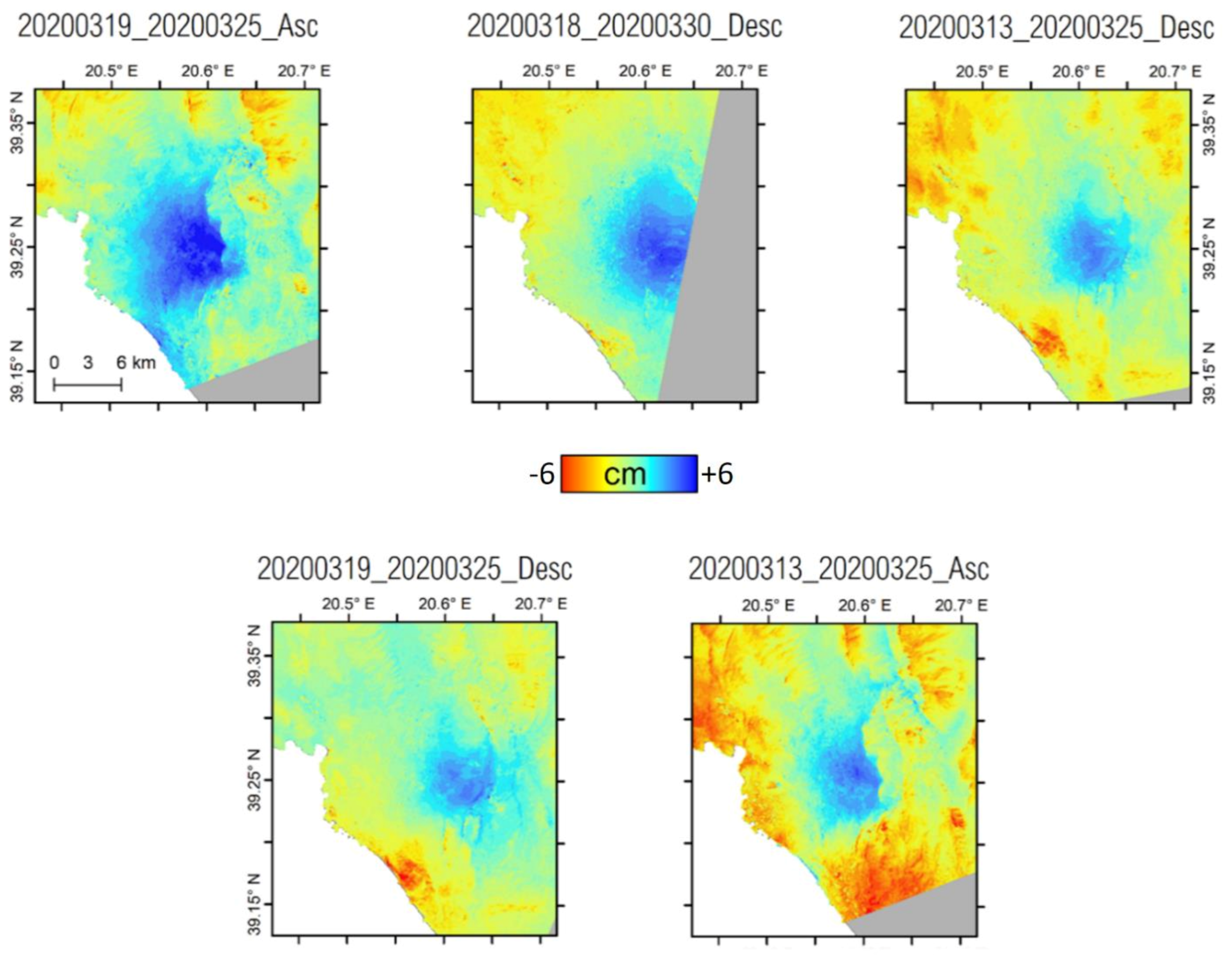
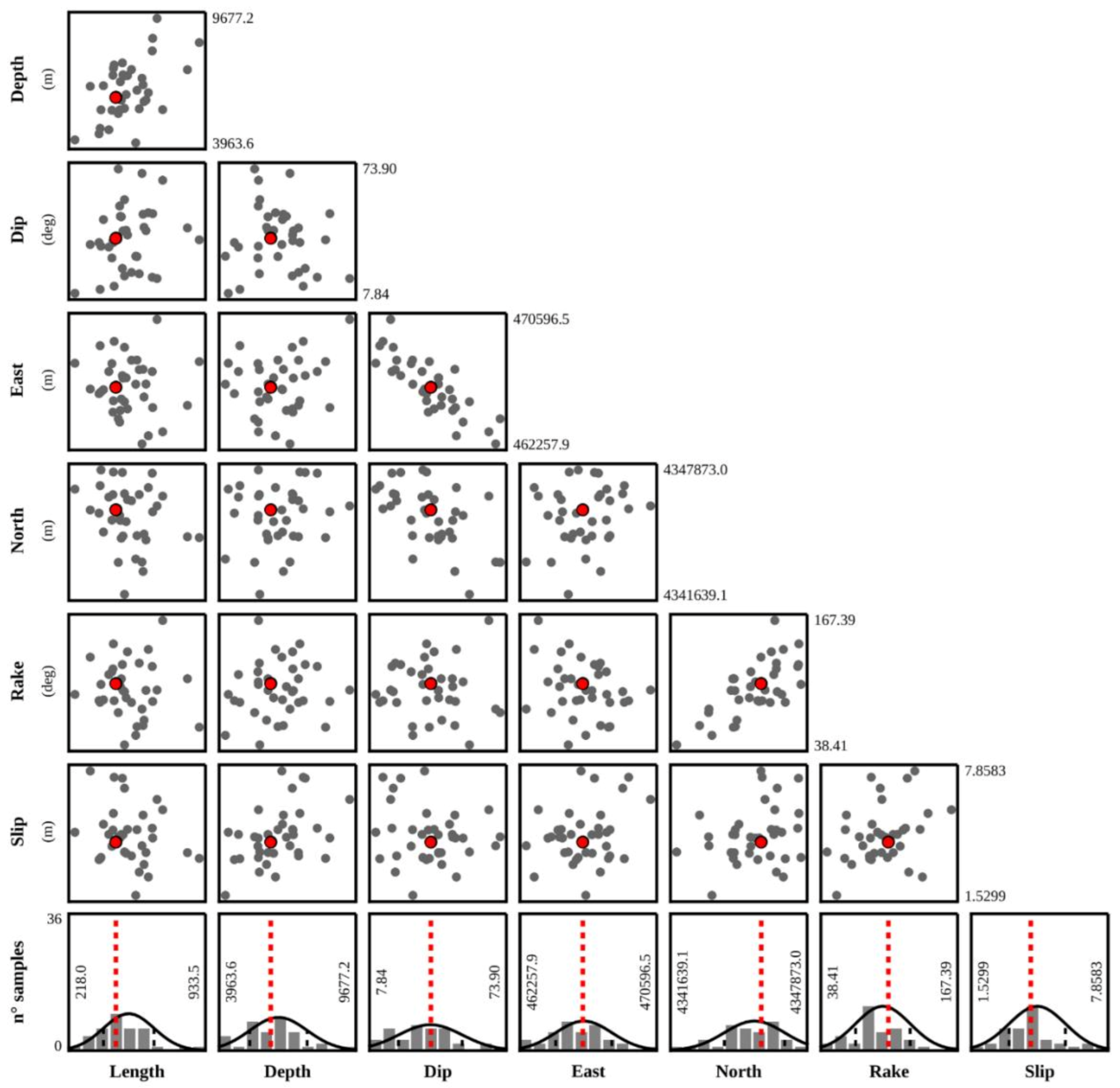
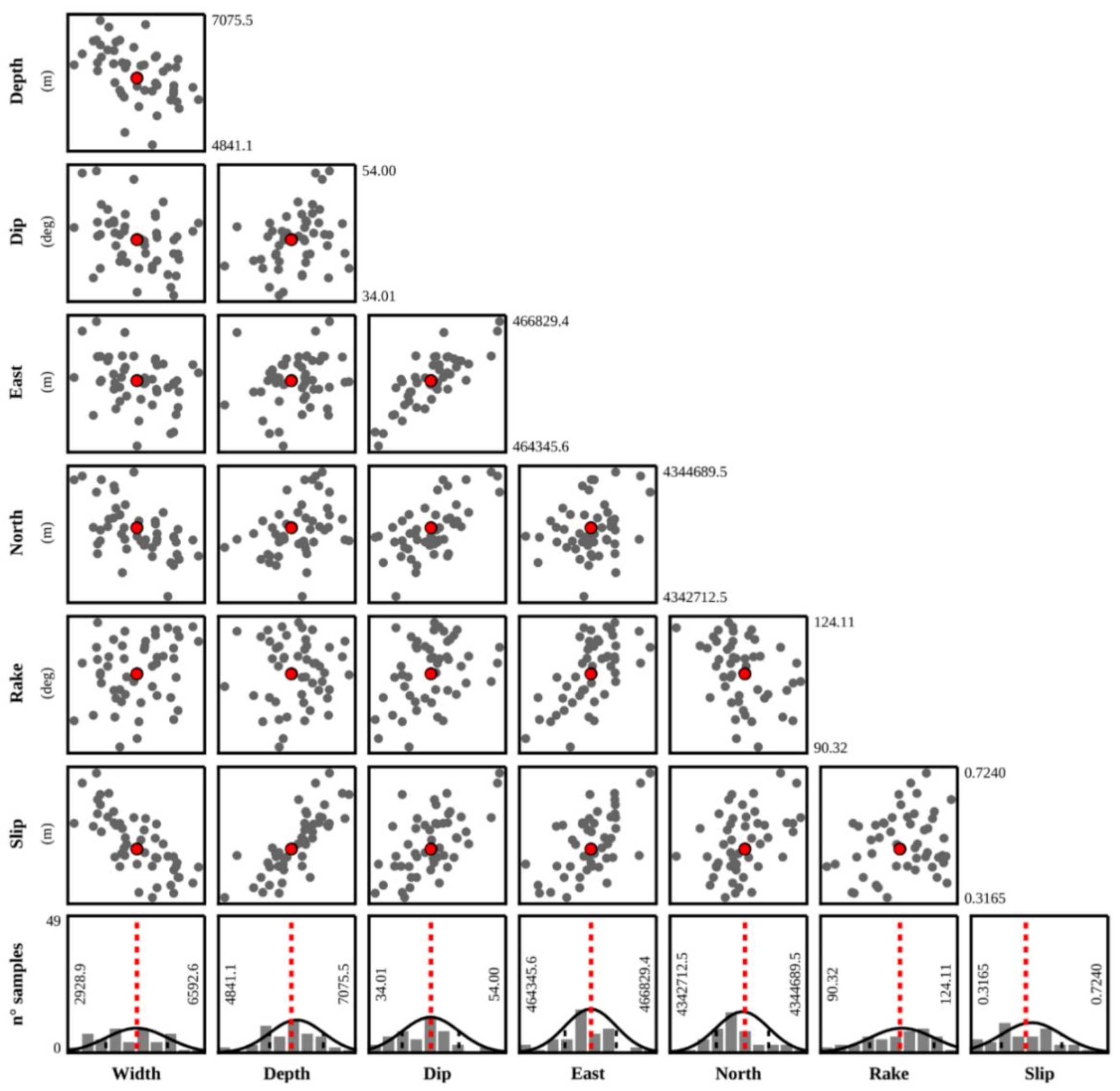
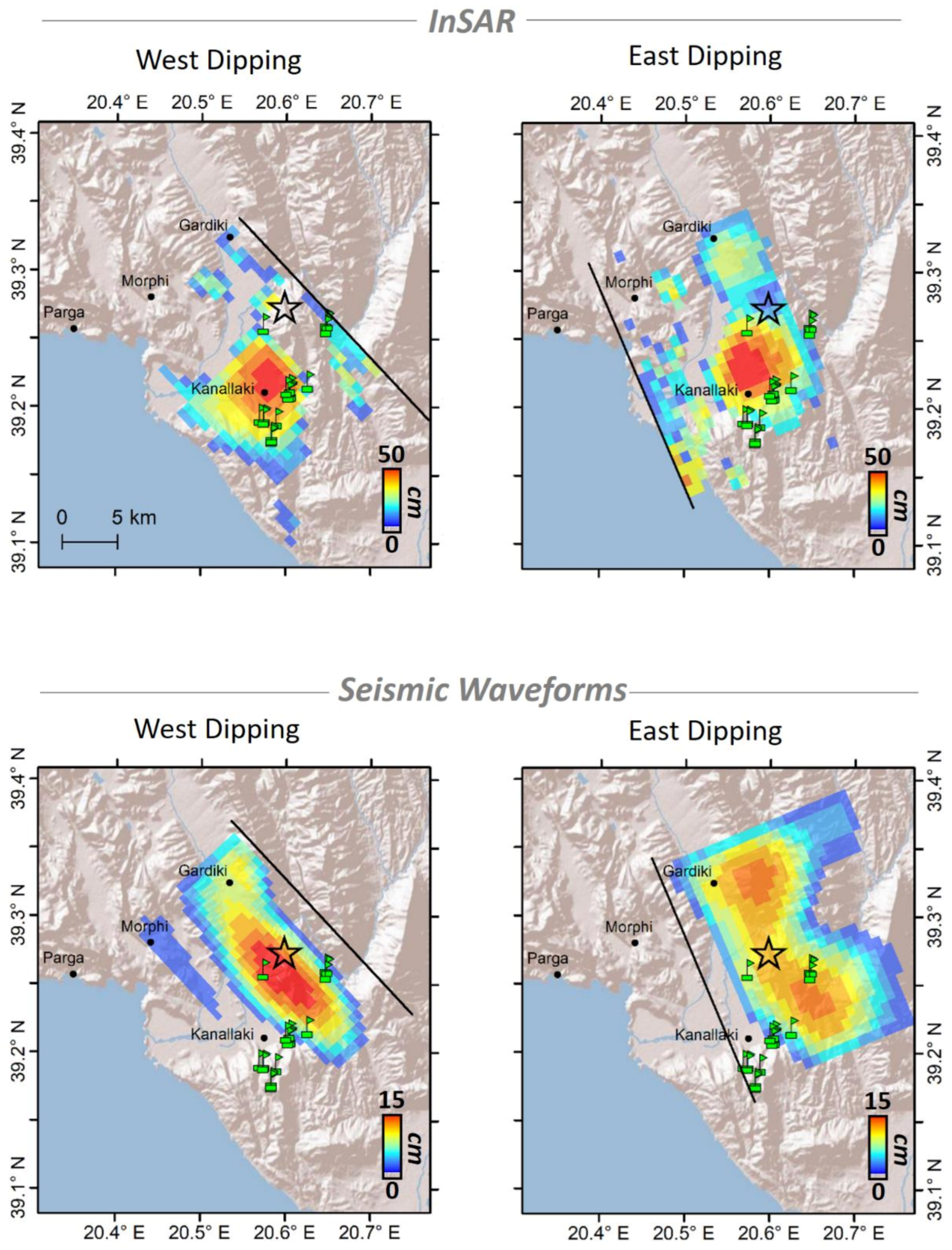
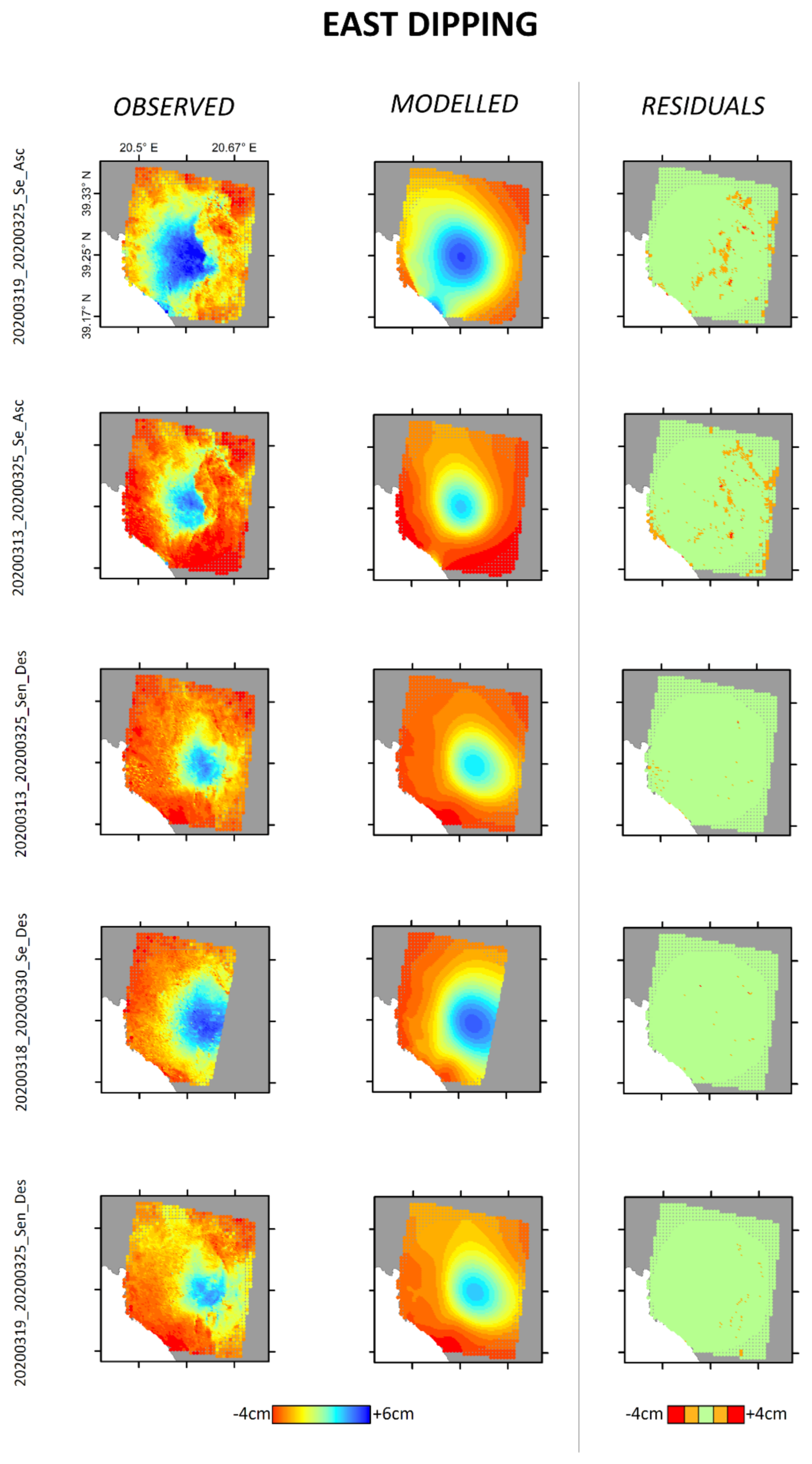

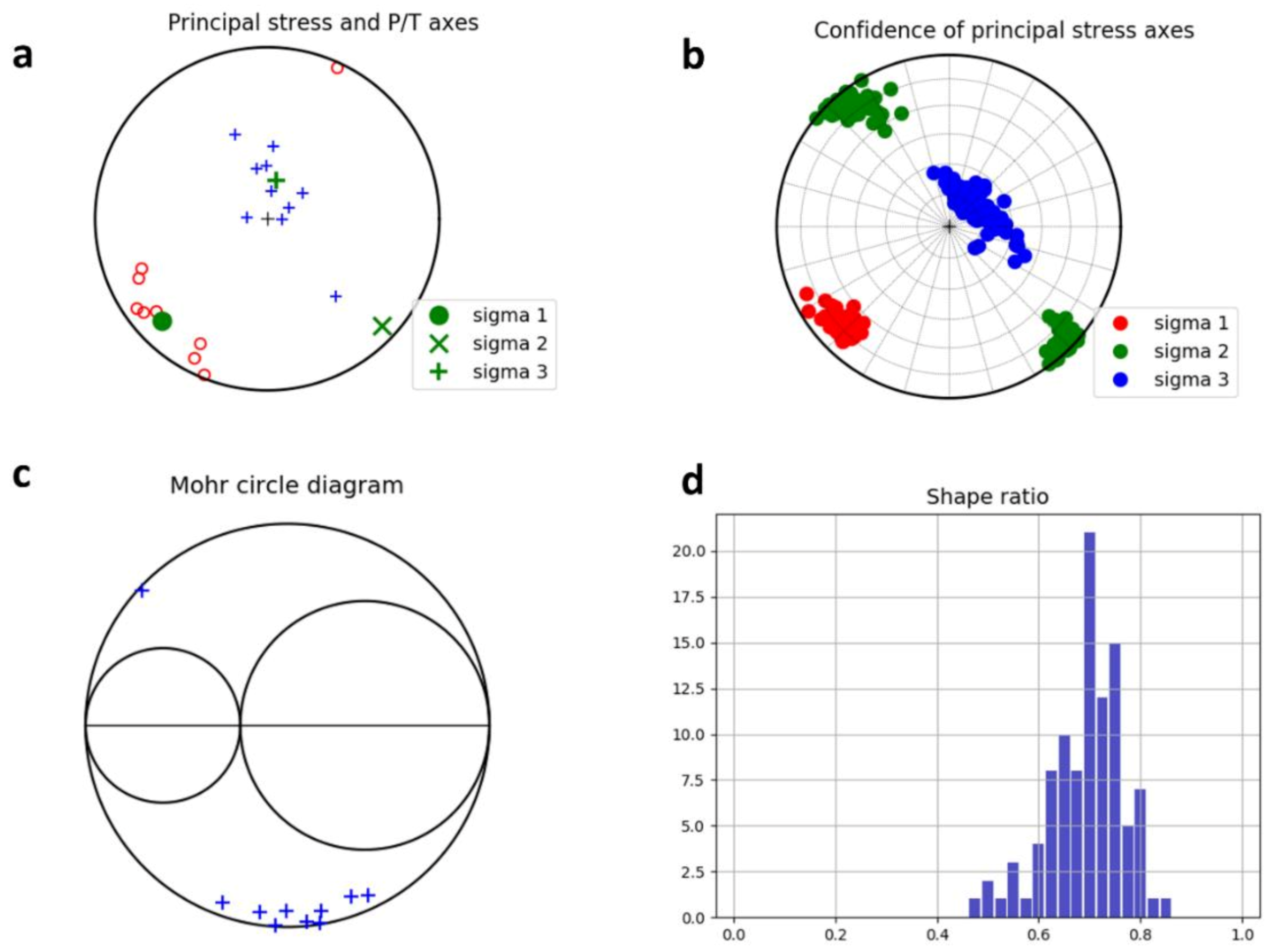
| Satellite | Pre-Event | Post-Event | Pass | Δt (Days) |
|---|---|---|---|---|
| Sentinel-1 | 19/03/2020 | 25/03/2020 | Asc | 6 |
| Sentinel-1 | 13/03/2020 | 25/03/2020 | Asc | 12 |
| Sentinel-1 | 18/03/2020 | 30/03/2020 | Desc | 12 |
| Sentinel-1 | 13/03/2020 | 25/03/2020 | Desc | 12 |
| Sentinel-1 | 19/03/2020 | 25/03/2020 | Desc | 6 |
| Ref | Origin Time (UTC) | Lat °N | Lon °E | Depth (km) | Mw | Strike (°) | Dip (°) | Rake (°) | Strike (°) | Dip (°) | Rake (°) | DC % |
|---|---|---|---|---|---|---|---|---|---|---|---|---|
| GCMT | 00:49:54 | 39.17 | 20.55 | 13 | 5.7 | 337 | 39 | 119 | 121 | 57 | 69 | 86 |
| GFZ | 00:49:53 | 39.36 | 20.61 | 16 | 5.7 | 318 | 37 | 90 | 137 | 52 | 89 | 92 |
| AUTH | 00:49:52 | 39.30 | 20.62 | 7 | 5.7 | 336 | 38 | 105 | 137 | 53 | 78 | 100 |
| USGS | 00:49:52 | 39.35 | 20.56 | 14 | 5.7 | 317 | 51 | 87 | 141 | 38 | 93 | 97 |
| UOA | 00:49:51 | 39.31 | 20.48 | 14 | 5.6 | 313 | 21 | 80 | 144 | 69 | 94 | 100 |
| INGV | 00:49:51 | 39.16 | 20.56 | 14 | 5.7 | 333 | 42 | 107 | 131 | 50 | 75 | 99 |
| IPGP | 00:49:51 | 39.35 | 20.56 | 10 | 5.8 | 331 | 35 | 100 | 139 | 56 | 83 | 100 |
| OCA | 00:49:51 | 39.29 | 20.61 | 5 | 5.7 | 315 | 45 | 90 | 135 | 45 | 90 | 100 |
| NOA | 00:49:51 | 39.33 | 20.52 | 8 | 5.5 | 315 | 33 | 92 | 132 | 57 | 89 | 85 |
| This work | 00:49:51.8 | 39.304 | 20.621 | 7 | 5.7 | 337 | 37 | 106 | 137 | 55 | 78 | 97 |
| Date YYYYMMDD | Origin Time (UTC) | Lat (°N) | Lon (°E) | Depth (km) | Mw | Strike (°) | Dip (°) | Rake (°) | Strike (°) | Dip (°) | Rake (°) | DC % | VR % |
|---|---|---|---|---|---|---|---|---|---|---|---|---|---|
| 20200201 | 21:22:22 | 39.168 | 20.591 | 4 | 4.4 | 2 | 44 | 154 | 112 | 72 | 49 | 44 | 67 |
| 20200320 | 21:38:30 | 39.304 | 20.615 | 6 | 4.2 | 341 | 31 | 125 | 121 | 65 | 71 | 74 | 60 |
| 20200321 | 00:49:52 | 39.304 | 20.621 | 7 | 5.7 | 337 | 37 | 106 | 137 | 55 | 78 | 97 | 81 |
| 20200323 | 04:41:03 | 39.230 | 20.624 | 6 | 3.9 | 291 | 44 | 15 | 191 | 80 | 133 | 91 | 80 |
| 20200324 | 15:46:10 | 39.281 | 20.567 | 6 | 3.6 | 285 | 27 | 72 | 125 | 64 | 99 | 73 | 37 |
| 20200325 | 09:49:45 | 39.279 | 20.636 | 9 | 3.9 | 12 | 36 | 143 | 133 | 69 | 60 | 100 | 84 |
| 20200325 | 22:24:40 | 39.242 | 20.602 | 7 | 3.6 | 285 | 43 | 80 | 118 | 48 | 99 | 71 | 34 |
| 20200413 | 00:44:41 | 39.216 | 20.549 | 6 | 3.4 | 290 | 36 | 79 | 124 | 55 | 98 | 67 | 27 |
| 20200413 | 05:15:16 | 39.264 | 20.587 | 8 | 3.3 | 303 | 49 | 102 | 106 | 43 | 77 | 89 | 75 |
| 20200528 | 21:32:36 | 39.243 | 20.605 | 7 | 3.3 | 348 | 39 | 126 | 125 | 59 | 64 | 70 | 58 |
| Intereferograms | East Dipping | West Dipping |
|---|---|---|
| 20200313_20200325_Se_Asc | 0.007 | 0.007 |
| 20200313_20200325_Sen_Des | 0.004 | 0.004 |
| 20200318_20200330_Se_Des | 0.003 | 0.003 |
| 20200319_20200325_Se_Asc | 0.006 | 0.007 |
| 20200319_20200325_Sen_Des | 0.004 | 0.004 |
| Strike ° | Dip ° | Rake ° | Geodetic Moment (N m) | Moment Magnitude | |
|---|---|---|---|---|---|
| West Dipping | 137 | 43 | 109 | 6.96·1017 | 5.8 |
| East Dipping | 337 | 37 | 102 | 9.44·1017 | 5.9 |
| Stress Axis | Azimuth ° | Plunge ° |
|---|---|---|
| σ1 | 225 | 15 |
| σ2 | 133 | 9 |
| σ3 | 13 | 71 |
| Id | Strike ° | Dip ° | Rake ° |
|---|---|---|---|
| 1 | 125 | 50 | 78 |
| 2 | 340 | 20 | 118 |
Publisher’s Note: MDPI stays neutral with regard to jurisdictional claims in published maps and institutional affiliations. |
© 2021 by the authors. Licensee MDPI, Basel, Switzerland. This article is an open access article distributed under the terms and conditions of the Creative Commons Attribution (CC BY) license (https://creativecommons.org/licenses/by/4.0/).
Share and Cite
Svigkas, N.; Kiratzi, A.; Antonioli, A.; Atzori, S.; Tolomei, C.; Salvi, S.; Polcari, M.; Bignami, C. Earthquake Source Investigation of the Kanallaki, March 2020 Sequence (North-Western Greece) Based on Seismic and Geodetic Data. Remote Sens. 2021, 13, 1752. https://doi.org/10.3390/rs13091752
Svigkas N, Kiratzi A, Antonioli A, Atzori S, Tolomei C, Salvi S, Polcari M, Bignami C. Earthquake Source Investigation of the Kanallaki, March 2020 Sequence (North-Western Greece) Based on Seismic and Geodetic Data. Remote Sensing. 2021; 13(9):1752. https://doi.org/10.3390/rs13091752
Chicago/Turabian StyleSvigkas, Nikos, Anastasia Kiratzi, Andrea Antonioli, Simone Atzori, Cristiano Tolomei, Stefano Salvi, Marco Polcari, and Christian Bignami. 2021. "Earthquake Source Investigation of the Kanallaki, March 2020 Sequence (North-Western Greece) Based on Seismic and Geodetic Data" Remote Sensing 13, no. 9: 1752. https://doi.org/10.3390/rs13091752
APA StyleSvigkas, N., Kiratzi, A., Antonioli, A., Atzori, S., Tolomei, C., Salvi, S., Polcari, M., & Bignami, C. (2021). Earthquake Source Investigation of the Kanallaki, March 2020 Sequence (North-Western Greece) Based on Seismic and Geodetic Data. Remote Sensing, 13(9), 1752. https://doi.org/10.3390/rs13091752






